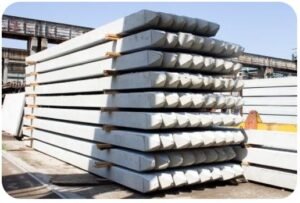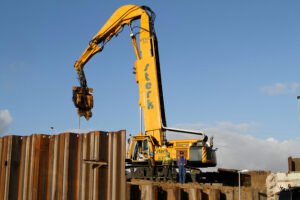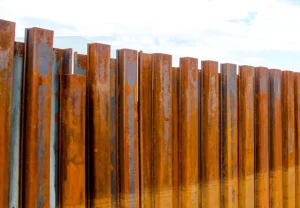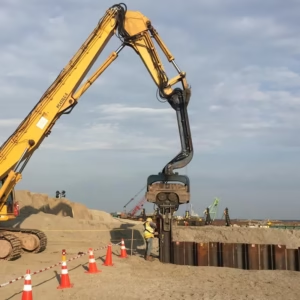Sheet Pile Retaining Wall, and How Does it Function in Construction?
A sheet pile retaining wall holds back soil or water and prevents erosion or collapse of nearby materials. It uses long, interlocking sheets made of steel, vinyl, or wood, which engineers drive vertically into the ground to form a continuous barrier. Builders install these walls in tight spaces or environments that require temporary or permanent soil retention, such as coastlines, riverbanks, construction pits, or basements.
The wall resists lateral pressures from soil or water. Once installed, the interlocking sheets create a solid barrier that withstands significant earth or hydrostatic pressure. Engineers determine the driving depth based on soil conditions and expected loads. The wall gains its strength from its embedded depth and the passive resistance of the soil below the excavation level.
What Are the Main Types of Materials Used in These Retaining Systems?
There are several materials commonly used in the construction of sheet pile retaining walls:
- Steel Sheet Piles Steel is the most common material due to its high strength, durability, and ability to withstand heavy loads and harsh environments. Steel sheets can be reused, making them cost-effective for temporary works.
- Vinyl or PVC Sheet Piles Vinyl sheet piles offer excellent resistance to corrosion and chemical exposure, especially in marine or polluted environments. They are lightweight and suitable for low-load applications.
- Wooden Sheet Piles Timber is often used for temporary structures or light-duty projects. It is economical and easier to handle, but lacks the durability of steel or vinyl, especially in wet conditions.
- Concrete Sheet Piles Precast concrete sheets are less common but are used in specific long-term or high-durability applications. They are typically more massive and require specialized equipment to install.
According to Safeway Piling and Construction, the primary materials used for sheet piles include steel, precast concrete, vinyl, and composite. Each material is chosen based on structural requirements, environmental conditions, and project budget.
What are the Advantages of Using Sheet Pile Retaining Walls in Marine or Waterfront Construction?
Sheet pile retaining walls offer several benefits in marine or waterfront applications:
-
Corrosion Resistance: Engineers use materials like coated steel and vinyl to effectively resist the corrosive effects of saltwater.
-
Speed of Installation: Crews install sheet piles quickly, making them ideal for tidal zones with limited construction windows.
-
Space Efficiency: Builders take advantage of the vertical, thin profile of sheet piles to maximize space in tight areas.
-
Flexibility: Designers adapt sheet pile systems to suit varying site conditions and modify or extend them as needed.
-
Water Tightness: Installers apply proper sealing techniques to ensure sheet pile walls block water intrusion effectively.
-
Reusability: Contractors extract and reuse steel piles in other projects, boosting both efficiency and sustainability.
How Do They Compare to Traditional Concrete Walls?
While both serve to retain soil or water, there are key differences:
-
Material and Weight: Manufacturers produce sheet piles from steel, vinyl, or timber, making them lighter than bulky concrete walls.
-
Installation Method: Crews drive sheet piles into the ground, while they build concrete walls by pouring or placing precast sections using extensive formwork and allowing for curing time.
-
Environmental Suitability: Engineers choose sheet piles for wet, soft, or marine soils, and prefer concrete for dry areas with heavy load requirements.
-
Reuse and Flexibility: Workers remove and reuse sheet piles, unlike concrete structures, which typically remain fixed.
-
Aesthetics and Finish: Designers often select concrete walls when they want more finish and architectural design options.
What’s the Typical On-Site Installation Process Like?
The installation process involves the following steps:
-
Site Preparation: Crews clear and level the area, and mark or relocate utilities before installation begins.
-
Setting a Guide Frame: Workers install a guide frame to ensure they align the piles correctly and maintain proper spacing.
-
Driving the Piles: Operators use specialized machinery to drive the sheet piles into the ground, allowing the interlocking edges to form a continuous wall.
-
Cutting or Capping: Workers trim or cap the tops of the piles with concrete or steel to create a finished edge or add structural support.
Safeway Piling and Construction follows a systematic process that includes site preparation, Pile driving, sheeting into place, alignment checks, and capping. The method used depends on soil conditions and project specifications.

Which Machines Are Used to Drive Sheet Piles Efficiently?
Several types of equipment are used depending on site conditions and pile type:
- Vibratory Hammers: These are the most common tools for driving sheet piles, especially in granular or loose soils.
- Diesel Hammers: Used when more force is needed, particularly in denser soils or where deep penetration is required.
- Press-In Machines: Ideal for urban or noise-sensitive areas, these machines push piles into the ground silently and with minimal vibration.
- Excavators with Pile Drivers: Used in small-scale projects or restricted access sites.
How Does Soil Condition Impact the Wall’s Design and Performance?
Soil type plays a critical role in determining the design, installation method, and overall performance of sheet pile retaining walls. Soil properties—such as cohesion, friction angle, density, and moisture content—directly affect how much lateral pressure the wall must resist and determine how deep engineers must drive the piles.
For instance, cohesive soils like clay can exert significant pressure on the wall due to their plastic nature and water retention. They may also shrink and swell with moisture changes, which affects wall stability. In contrast, granular soils such as sand or gravel allow for easier pile driving but can shift quickly under dynamic loading, necessitating stronger anchoring or deeper embedment. Soft or loose soils may require pre-treatment or denser pile spacing to achieve the desired structural performance.
Engineers conduct a geotechnical investigation before design to assess soil layers, bearing capacity, and groundwater conditions. This data ensures that the wall is designed with the appropriate pile length, spacing, and material to retain the surrounding soil mass safely.
Soil characteristics such as cohesion, density, and groundwater conditions directly impact wall design. Safeway Piling and Construction conducts thorough geotechnical investigations to ensure optimal wall strength and stability in varying soil conditions.

Methods for Reinforcing Against Lateral Earth Pressure
While the primary structural strength of a sheet pile wall comes from the material and interlocking design, reinforcement is often necessary to resist lateral earth pressures, especially in high-load environments or deep excavations.
Reinforcement methods include:
- Increasing pile section modulus: Using sheet piles with a higher cross-sectional strength enhances their ability to resist bending and shear forces.
- Using wales or struts: Horizontal members (wales) distribute load across multiple piles, while struts (bracing between opposite walls) resist inward pressure in excavation pits.
- Anchoring systems: Tiebacks or deadman anchors provide external support, reducing the bending moment on the wall.
In some cases, composite walls may be used, where sheet piles are combined with concrete or steel beams for added structural integrity.
The Importance of Anchoring Systems in Wall Stability
Anchoring systems are vital components for maintaining the stability of sheet pile retaining walls, especially those exposed to significant lateral forces or high retained heights.
Common types of anchoring systems include:
- Tiebacks: Steel rods or cables drilled into the ground behind the wall and anchored to stable soil or rock. They help counteract the forward push of retained soil.
- Deadman Anchors: These involve burying a horizontal beam or concrete block that connects to the wall via tie rods, relying on the passive resistance of the surrounding soil to hold the system in place.
- Anchor plates and walers: These help distribute loads and minimize localized stress on the sheet piles.
Anchoring systems such as ground anchors and deadman anchors help counteract lateral earth forces. Safeway Piling and Construction designs reliable anchoring systems to enhance wall rigidity and prevent structural failure.
How Long Can These Retaining Solutions Last in the Field?
The lifespan of a sheet pile retaining wall depends on several factors, including the material used, environmental exposure, and maintenance practices.
- Steel sheet piles with protective coatings or galvanization typically last 40–75 years under moderate environmental conditions. In marine environments, corrosion can shorten the lifespan unless special alloys or coatings are used.
- Vinyl or PVC piles are resistant to rot and corrosion, offering service lives of 50+ years in non-load-bearing applications.
- Timber sheet piles, when treated properly, can last 20–30 years but are generally suited to temporary or low-load projects.
Proper installation and ongoing maintenance significantly influence the actual service life.

Essential Maintenance Practices to Maximize Longevity
To maximize longevity and performance, regular maintenance is essential:
- Visual Inspections: Periodically inspect for corrosion, rust, cracks, or misalignment.
- Corrosion Protection: Reapply coatings or cathodic protection systems as needed.
- Drainage Management: Ensure weep holes or drainage paths are clear to reduce water pressure buildup.
- Vegetation Control: Remove plant growth that can trap moisture or cause structural damage.
- Anchor System Checks: Inspect tiebacks and anchor plates for signs of fatigue or loosening.
Regular inspections, rust protection, and minor repairs are essential. Safeway Piling and Construction offers maintenance services that include monitoring structural integrity and ensuring drainage systems remain functional.
Techniques Used to Evaluate Load-Bearing Capacity
Engineers evaluate load-bearing capacity through a combination of design calculations, soil data, and sometimes field tests:
- Geotechnical Analysis: Soil investigations reveal properties such as bearing capacity, cohesion, and friction, which are used in load calculations.
- Structural Analysis: Software modeling or manual methods help determine bending moments, shear forces, and deflection.
- Load Testing: In some cases, piles are load-tested in the field using hydraulic jacks to measure deflection and capacity.
- Safety Factors: Engineers apply safety margins to account for uncertainties in loading, soil variability, and environmental conditions.
This assessment ensures the wall can safely support earth pressure, water loads, and any external loads such as vehicles or structures above.
Sheet pile retaining walls, when designed with careful attention to soil conditions and reinforced appropriately, provide a robust and flexible solution for soil retention. Their performance hinges on thoughtful engineering, quality materials, and regular maintenance.
Conclusion on “Sheet Pile Retaining Wall” for Safeway Piling and Construction:
At Safeway Piling and Construction, we recognize the importance of reliable and efficient earth retention systems, and sheet pile retaining walls are a key solution we offer. These walls provide durable support for excavation, shoreline protection, and deep foundation projects, especially in areas with limited space or challenging soil conditions. With our expertise and commitment to quality, Safeway ensures that every sheet pile installation is executed with precision, using high-grade materials and advanced techniques. Whether for commercial, industrial, or marine applications, our sheet pile retaining wall solutions deliver long-term stability, safety, and value.





